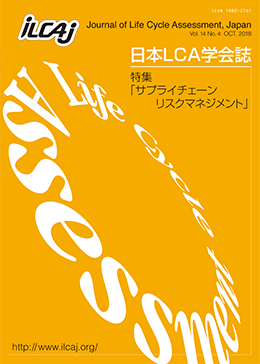Volume 14, Issue 4
Displaying 1-18 of 18 articles from this issue
- |<
- <
- 1
- >
- >|
Contents
-
2018 Volume 14 Issue 4 Pages Toc_1-Toc_4
Published: 2018
Released on J-STAGE: December 01, 2018
Download PDF (942K)
Foreword
-
2018 Volume 14 Issue 4 Pages 255
Published: 2018
Released on J-STAGE: December 01, 2018
Download PDF (858K)
Special Issue: Supply Chain Risk Management
Commentary and Discussion
-
2018 Volume 14 Issue 4 Pages 256-266
Published: 2018
Released on J-STAGE: December 01, 2018
Download PDF (1471K) -
2018 Volume 14 Issue 4 Pages 267-276
Published: 2018
Released on J-STAGE: December 01, 2018
Download PDF (1362K) -
2018 Volume 14 Issue 4 Pages 277-283
Published: 2018
Released on J-STAGE: December 01, 2018
Download PDF (1382K) -
2018 Volume 14 Issue 4 Pages 284-291
Published: 2018
Released on J-STAGE: December 01, 2018
Download PDF (1493K) -
2018 Volume 14 Issue 4 Pages 292-301
Published: 2018
Released on J-STAGE: December 01, 2018
Download PDF (1938K)
Research Article
-
2018 Volume 14 Issue 4 Pages 302-318
Published: 2018
Released on J-STAGE: October 25, 2018
Download PDF (3859K)
Research Article
-
2018 Volume 14 Issue 4 Pages 319-331
Published: 2018
Released on J-STAGE: October 25, 2018
Download PDF (3792K)
Report
-
2018 Volume 14 Issue 4 Pages 332-339
Published: 2018
Released on J-STAGE: December 01, 2018
Download PDF (5493K) -
2018 Volume 14 Issue 4 Pages 340-341
Published: 2018
Released on J-STAGE: December 01, 2018
Download PDF (3092K)
Column
-
2018 Volume 14 Issue 4 Pages 342-343
Published: 2018
Released on J-STAGE: December 01, 2018
Download PDF (756K)
Introduction of Research Group
-
2018 Volume 14 Issue 4 Pages 344-346
Published: 2018
Released on J-STAGE: December 01, 2018
Download PDF (4119K)
Introduction of Supporting Corporate Members
-
2018 Volume 14 Issue 4 Pages 347-349
Published: 2018
Released on J-STAGE: December 01, 2018
Download PDF (3150K)
Index in 2018
-
2018 Volume 14 Issue 4 Pages 350-354
Published: 2018
Released on J-STAGE: December 01, 2018
Download PDF (321K)
Supporting Members
-
2018 Volume 14 Issue 4 Pages 355
Published: 2018
Released on J-STAGE: December 01, 2018
Download PDF (714K)
All about ILCAJ
-
2018 Volume 14 Issue 4 Pages 356-362
Published: 2018
Released on J-STAGE: December 01, 2018
Download PDF (1089K)
Announcement
-
2018 Volume 14 Issue 4 Pages i-vii
Published: 2018
Released on J-STAGE: December 01, 2018
Download PDF (946K)
- |<
- <
- 1
- >
- >|
